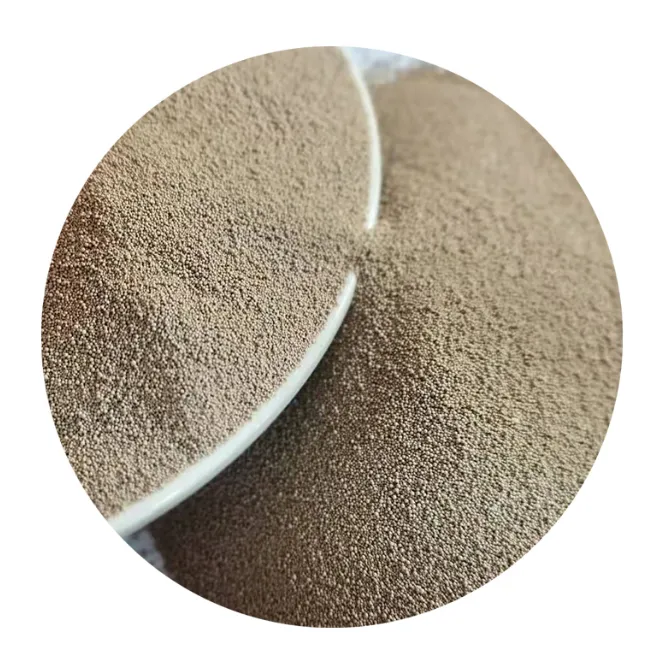The metal casting industry has long grappled with challenges like airborne silica dust, high waste generation, and occupational health risks. Ceramsite foundry sand emerges as a revolutionary solution, offering unparalleled advantages over traditional silica sand. Composed of sintered clay or industrial byproducts, this lightweight, spherical granular material minimizes dust emissions due to its low friability and high thermal stability. Foundries using sand for metal casting often face worker safety concerns, but ceramsite foundry sand reduces respirable crystalline silica (RCS) exposure by up to 90%, aligning with global OSHA and EU workplace safety standards. Its uniform particle size distribution ensures optimal permeability during mold creation, reducing gas defects in final castings. For stainless steel sand casting foundry operations, this translates to fewer rejected parts and enhanced productivity. Additionally, its reusability—up to 10 cycles without performance loss—makes it a cost-effective and eco-friendly alternative, slashing landfill dependency by 70%.

Why Stainless Steel Sand Casting Demands Advanced Solutions
Sand casting stainless steel requires precision to handle the alloy’s high melting point (1,400–1,530°C) and susceptibility to oxidation. Traditional sands often degrade under extreme temperatures, releasing hazardous dust and compromising mold integrity. Ceramsite foundry sand, with its refractory properties (withstanding up to 1,650°C), maintains dimensional stability, ensuring crisp details in complex geometries like valve bodies or turbine blades. In stainless steel sand casting foundry settings, this sand minimizes veining and burn-on defects, reducing post-casting machining by 30%. Its low thermal expansion coefficient also prevents mold cracking, a common issue when casting thick-walled stainless components. Furthermore, the non-reactive nature of ceramsite avoids chemical interactions with molten metal, preserving the corrosion resistance that defines stainless steel. For industries prioritizing both quality and worker safety, this material is indispensable.
Dust Suppression: How Ceramsite Sand Protects Workers
Respirable silica dust from conventional sand for metal casting is a leading cause of silicosis, lung cancer, and chronic obstructive pulmonary disease (COPD) among foundry workers. Ceramsite foundry sand addresses this crisis through its dust-free properties. Unlike angular silica grains that fracture into fine particles, ceramsite’s rounded structure resists breakdown even under mechanical stress. Trials in stainless steel sand casting foundry facilities show airborne particulate levels below 0.1 mg/m³—well under the 0.025 mg/m³ threshold recommended by NIOSH. This reduction eliminates the need for costly respiratory PPE upgrades or ventilation retrofits. Moreover, ceramsite’s low moisture requirement (3–5% vs. silica’s 5–8%) decreases steam generation during pouring, enhancing visibility and reducing slip hazards. By integrating this sand, foundries not only comply with safety regulations but also boost employee morale and retention through healthier workspaces.
Optimizing Efficiency in Sand Casting Stainless Steel
Efficiency in sand casting stainless steel hinges on minimizing cycle times while maximizing output quality. Ceramsite foundry sand excels here through faster shakeout processes. Its low adhesion to metal surfaces allows molds to collapse cleanly post-casting, cutting shakeout time by 40%. This is critical for high-volume stainless steel sand casting foundry operations producing pump housings or marine fittings. The sand’s high refractoriness also enables thinner mold walls, reducing material usage by 15–20% without sacrificing strength. Automated reclamation systems can regenerate ceramsite sand with minimal energy input, unlike silica sand, which often requires washing and drying. Foundries report a 25% increase in daily production rates after switching to ceramsite, alongside a 50% drop in waste disposal costs. These gains make it a strategic asset for competitive manufacturers aiming to scale sustainably.
FAQs: Ceramsite Sand and Stainless Steel Casting
Is ceramsite sand more expensive than traditional silica sand?
While initial costs are 20–30% higher, ceramsite foundry sand’s reusability and reduced waste disposal expenses result in 50% lower long-term costs. Its durability also decreases downtime for mold repairs.
Can ceramsite sand handle high-chromium stainless steel alloys?
Yes. Its neutral pH and thermal stability make it ideal for casting grades like 316L or 2205 duplex stainless steel, preventing slag formation and surface pitting.
How often should ceramsite sand be replaced?
With proper reclamation, it lasts 8–10 cycles. Regular screening to remove fines extends its lifespan, ensuring consistent performance in sand casting stainless steel processes.
Does ceramsite sand work with automated molding systems?
Absolutely. Its flowability and uniformity make it compatible with robotic green sand molding and no-bake systems, enhancing precision in stainless steel sand casting foundry setups.
What industries benefit most from this sand?
Aerospace, automotive, and energy sectors rely on it for critical stainless components. Its safety and efficiency gains also appeal to medical device and food machinery manufacturers.
Transform Your Foundry Today
Upgrade to ceramsite foundry sand and redefine safety, efficiency, and quality in your sand casting stainless steel operations. As a trusted wholesale partner, we guarantee competitively priced, certified materials tailored to your production needs. Visit our website to request samples or place bulk orders. Protect your workforce—and your bottom line—with innovation that delivers.
Next:Ceramic Sand vs Silica in Sand 3D Printing: Precision Meets Durability
